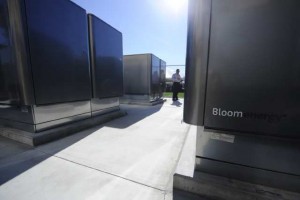Fuel Cell Offers to Save World: World Says No Thanks
http://www.dailyimpact.net/2011/02/19/fuel-cell-offers-to-save-world-world-says-no-thanks/

Each Bloom box shown provides 100 kw cheap, clean energy for CalTech. Other clients include eBay, Google and Coke.
One year ago, the venerable televison news program 60 Minutes broke a blockbuster story that (as The Daily Impact observed at the time —Hope Springs: Can a Fuel Cell Save Us?) made even energy pessimists feel a pang of hope. (Okay, 60 Minutes didn’t exactly break the story, but they did introduce it for the first time to a mass audience.) Bloom Energy of Sunnyvale, California had brought to market a reliable, efficient, clean and relatively cheap fuel cell that was scalable from a coffee-can-sized power source for a home to a greyhound-bus-sized industrial plant.
The technology was exciting. Its inventor, Bloom Energy founder and CEO K.R. Sridhar, found a way to make a 25-watt fuel cell from a wafer made of sand and coated with special inks that made one side of the wafer the cathode, the other the anode, of the chemical battery. Its manufacture was thus less exotic, less dependent on rare and hard-to-get materials and less toxic to the environment than that of previous versions of the fuel cell. Moreover, the Bloom cell can make use of a wide variety of fuels, from the existing and widely available petroleum derivatives to biogases.
All of this would have been fascinating enough as theory, or as a demonstration project, but the jaw-dropping 60 Minutes piece went on to reveal that industrial-size Bloom Boxes, as they inevitably came to be known, had for some time been serving key installations of companies such as Google, eBay, FedEx, Staples and Coca-Cola.
But the truly stunning part of the revelation was the vision of the future that the product made possible. This was, it seemed, the closest anyone had come to the mythical, always-imminent technological breakthrough that the industrialists and technophiles have been assuring us for decades would come along in time to save us from our energy gluttony and replace oil as the heart of our consumptive lifestyles. Suddenly we could actually, realistically imagine a future in which electricity would be produced where it was needed, without pollution, without necessarily using fossil fuels (although the first units are using natural gas), andwithout transcontinental transmission lines. It could at last be the end of strings-on-sticks providing the shaky foundation for all our high technology. If we could turn that corner, quickly, maybe we could avoid the catastrophe that the end of cheap and plentiful oil holds in store for us.
New York Mayor Michael Bloomberg grasped these implications: “My first reaction was this was a company guaranteed for greatness. When we look at Bloom Energy, we are looking at the future of business, at the future of the economy, at the future of America.”
That was a year ago, and that, as far as the mass media were concerned, was that. Bloom held its formal unveiling of the project the next day, and after a smattering of perfunctory “Can the Bloom Box Save the World?” stories, sank from view. (Note the journalistic technique: first, burden the technology or methodology with the need to save the world, all of it, and then find somewhere a skeptic to say it probably wouldn’t, couldn’t, or oughtn’t save the whole world, and thus can be disregarded.)
Sic Transit Hope.
It’s happened before, of course. As readers of Brace for Impact: Surviving the Crash of the Industrial Age by Sustainable Living(and few others) will know, a man named Jack Shaeffer showed us in 1969 how to end point-source water pollution in this country. Period. Not only did it work, it caused the Congress and the Nixon administration to declare as a national goal of the United States the ending of all pollution of waterways by 1985. The only catch was that cities and real-estate developers would have to set aside a little bit of land for each sub-division and office park, to deal with the pollution where it was generated. Like Bloom, Shaeffer systems were installed by hundreds of communities and businesses, and worked as promised. Like Bloom, the Shaeffer solution was enveloped by a vast silence, punctuated only by the occasional yipping of professional skeptics funded by industrial polluters. Shaeffer’s solution vanished from the industrial world. Can Bloom’s be far behind?
Would it have been different if Bloom had not concentrated on the big, profitable, corporate installations, and instead had rolled out and promoted vigorously a $3,000, breadbox-sized power source for individual homes? Probably not. The deep national silence about the deadly problems we face, even about the solutions available for those problems, is armor-plated with money, protected by wholly-owned politicians and ratings-mad media, and apparently impenetrable.
The silence of the damned.


0 Comments:
Post a Comment
Subscribe to Post Comments [Atom]
<< Home